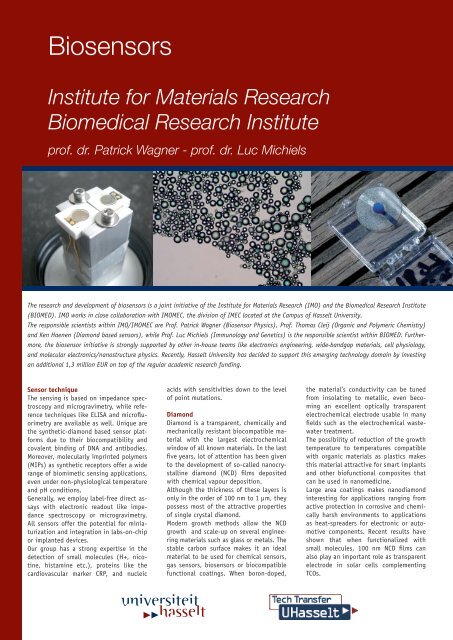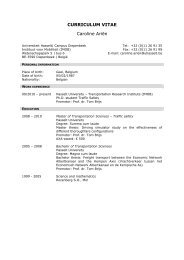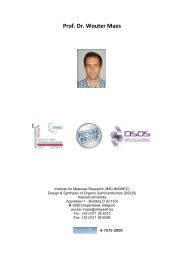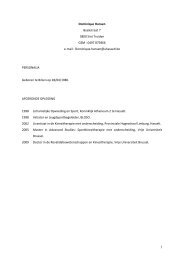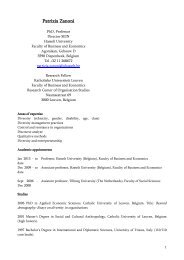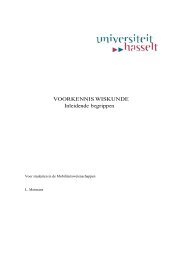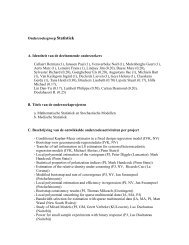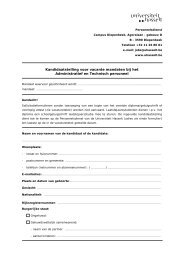Biosensors - UHasselt
Biosensors - UHasselt
Biosensors - UHasselt
Create successful ePaper yourself
Turn your PDF publications into a flip-book with our unique Google optimized e-Paper software.
<strong>Biosensors</strong><br />
Institute for Materials Research<br />
Biomedical Research Institute<br />
prof. dr. Patrick Wagner - prof. dr. Luc Michiels<br />
The research and development of biosensors is a joint initiative of the Institute for Materials Research (IMO) and the Biomedical Research Institute<br />
(BIOMED). IMO works in close collaboration with IMOMEC, the division of IMEC located at the Campus of Hasselt University.<br />
The responsible scientists within IMO/IMOMEC are Prof. Patrick Wagner (Biosensor Physics), Prof. Thomas Cleij (Organic and Polymeric Chemistry)<br />
and Ken Haenen (Diamond based sensors), while Prof. Luc Michiels (Immunology and Genetics) is the responsible scientist within BIOMED. Furthermore,<br />
the biosensor initiative is strongly supported by other in-house teams like electronics engineering, wide-bandgap materials, cell physiology,<br />
and molecular electronics/nanostructure physics. Recently, Hasselt University has decided to support this emerging technology domain by investing<br />
an additional 1,3 million EUR on top of the regular academic research funding.<br />
Sensor technique<br />
The sensing is based on impedance spectroscopy<br />
and microgravimetry, while reference<br />
techniques like ELISA and microfluorimetry<br />
are available as well. Unique are<br />
the synthetic-diamond based sensor platforms<br />
due to their biocompatibility and<br />
covalent binding of DNA and antibodies.<br />
Moreover, molecularly imprinted polymers<br />
(MIPs) as synthetic receptors offer a wide<br />
range of biomimetic sensing applications,<br />
even under non-physiological temperature<br />
and pH conditions.<br />
Generally, we employ label-free direct assays<br />
with electronic readout like impedance<br />
spectroscopy or microgravimetry.<br />
All sensors offer the potential for miniaturization<br />
and integration in labs-on-chip<br />
or implanted devices.<br />
Our group has a strong expertise in the<br />
detection of small molecules (H+, nicotine,<br />
histamine etc.), proteins like the<br />
cardiovascular marker CRP, and nucleic<br />
acids with sensitivities down to the level<br />
of point mutations.<br />
Diamond<br />
Diamond is a transparent, chemically and<br />
mechanically resistant biocompatible material<br />
with the largest electrochemical<br />
window of all known materials. In the last<br />
five years, lot of attention has been given<br />
to the development of so-called nanocrystalline<br />
diamond (NCD) films deposited<br />
with chemical vapour deposition.<br />
Although the thickness of these layers is<br />
only in the order of 100 nm to 1 µm, they<br />
possess most of the attractive properties<br />
of single crystal diamond.<br />
Modern growth methods allow the NCD<br />
growth and scale-up on several engineering<br />
materials such as glass or metals. The<br />
stable carbon surface makes it an ideal<br />
material to be used for chemical sensors,<br />
gas sensors, biosensors or biocompatible<br />
functional coatings. When boron-doped,<br />
the material’s conductivity can be tuned<br />
from insolating to metallic, even becoming<br />
an excellent optically transparent<br />
electrochemical electrode usable in many<br />
fields such as the electrochemical wastewater<br />
treatment.<br />
The possibility of reduction of the growth<br />
temperature to temperatures compatible<br />
with organic materials as plastics makes<br />
this material attractive for smart implants<br />
and other biofunctional composites that<br />
can be used in nanomedicine.<br />
Large area coatings makes nanodiamond<br />
interesting for applications ranging from<br />
active protection in corrosive and chemically<br />
harsh environments to applications<br />
as heat-spreaders for electronic or automotive<br />
components. Recent results have<br />
shown that when functionalized with<br />
small molecules, 100 nm NCD films can<br />
also play an important role as transparent<br />
electrode in solar cells complementing<br />
TCOs.
Biosensor development –biological<br />
aspects<br />
Biomed is developing label-free affinity<br />
biosensors for proteins and nucleic acids.<br />
As a proof of principle, the CRP affinity<br />
sensor allows for the fast detection of<br />
physiological relevant concentrations of<br />
the cardiovascular marker CRP, while our<br />
nucleic acid sensing devices allow for the<br />
detection of point mutations.<br />
Biosensor research at Biomed is also investing<br />
in the construction of new affinity<br />
sensing devices based on aptamer technology<br />
combined with our unique synthetic-diamond<br />
based sensor platform.<br />
This approach is very promising for the<br />
development of stable, reusable protein<br />
affinity sensing devices.<br />
<strong>Biosensors</strong> are being developed for the following application fields:<br />
1. Detection of drugs and small molecules: pH, penicillin, nicotine, histamine, caffeine<br />
2. Detection of proteins: complement-reactive protein CRP (cardiovascular marker)<br />
3. Characterization of genetic materials: detection of point mutations (SNP’s)<br />
The following topics have received a considerable international recognition (more than 10 invited lectures on international conferences<br />
in 2008):<br />
• The covalent coupling of DNA to nanocrystalline diamond, prepared in house by chemical vapor deposition. Diamond itself has bio- and<br />
hemocompatible properties and its electronic characteristics can be carefully adjusted to the demands of the experiment. The coupling<br />
technique has successfully been transferred to silicon surfaces and graphene-based carbon nanowalls.<br />
• The molecular imprinting of polymers (MIP) has proven to be a versatile instrument for creating synthetic receptors for a wide range of<br />
target molecules. These MIPs are highly stable as compared to e.g. immunoglobulins, have an infinite shelf life, and the cost of synthesis<br />
is extremely low.<br />
For additonal information:<br />
www.imo.uhasselt.be - Prof. Dr. Patrick Wagner -<br />
tel +32 (0) 11 26 88 95 - patrik.wagner@uhasselt.be<br />
www.uhasselt.be/techtransfer - dr. A.P.Bijnens -<br />
tel +32 (0) 11 26 80 17 - annpascale.bijnens@uhasselt.be<br />
Hasselt University – Campus Diepenbeek<br />
Agoralaan - Building D – B- 3590 Diepenbeek (Belgium)<br />
Hasselt University, campus Diepenbeek,<br />
is located in the center of the Euregion-Maas-Rhine.<br />
A shortdistance from Liège, Maastricht, Eindhoven, Leuven, Brussels,<br />
Antwerp, Aachen, and Cologne.


